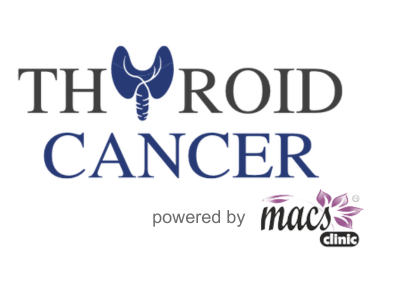Lymph node dissection: Robotic & Open
This page discusses the management of lymph nodes in the neck of a patient with thyroid cancer. Scarless robotic surgery by RABIT or RIA-MIND technique is routinely used for the purpose of lymph node dissection. Scarless robotic lymph node removal is a precise and reliable technology. It is minimally invasive and has optimal patient outcomes. It is for treating thyroid conditions. This site is developed by well-known expert on thyroid surgery Dr Sandeep Nayak from MACS Clinic, Bangalore, India.
About - Lymph Nodes and Thyroid Cancer
Lymph nodes are small, bean-shaped structures. They filter the lymph fluid and trap harmful bacteria and cancer cells. Doctors check if cancer has spread to the nearby lymph nodes in thyroid cancer patients. The oncologist recommends a suitable treatment protocol and prognosis if cancer cells are detected. In these cases, lymph node dissection is necessary.
Robotic Neck Dissection by RABIT technique both invented by Dr Sandeep Nayak are the latest, advanced, minimally invasive approaches. It is for removing lymph nodes in the neck. The surgery is performed with robotic precision.
Learn more and discover how robotic-assisted techniques could deliver better surgical outcomes, especially for lymph node dissection procedures. (link to my talk on YT)
When is Lymph Node Removal (Neck Dissection) needed for thyroid cancer?

Differentiated thyroid cancers (DTC): These include papillary thyroid cancer, follicular cancer, etc. These do not require lymph node removal routinely unless the nodes are involved.
Aggressive types of thyroid cancer: Medullary thyroid cancer and other aggressive varieties of thyroid cancer need lymph node dissection even if the scans not not show involvement of nodes.
Lymph Node Removal (Neck Dissection) During Thyroid Surgery

Lymph node dissection is a surgical procedure performed in thyroid cancer cases when there is evidence of lymph node involvement in DTCs. This is usually performed along with thyroid surgery by expert surgeons after proper diagnosis. It is important to note that lymph node dissection is not performed prophylactically, but rather when there is a confirmed presence of cancer cells in the lymph nodes. For more aggressive cancers the removal may be performed even if it is not involved.
Central Neck Dissection
Central neck dissection involves the removal of lymph nodes in the central compartment of the neck, also known as level 6 lymph nodes. These are the nodes surrounding the thyroid and are usually the nodes that get involved first by cancer. This procedure requires expert surgeons to perform this surgery as there is a very high risk to the recurrent laryngeal nerve which is responsible for voice and the parathyroid gland that is responsible for calcium levels in the blood. This surgery can be performed using robotic surgery using RABIT technique.
Lateral or Functional Neck Dissection
Lateral neck dissection is performed when there is clinical evidence of lymph node involvement in the lateral neck region. It involves the removal of lymph nodes in the lateral compartments of the neck which are called level 2 to 5. Lateral neck dissection is considered a therapeutic procedure to remove cancerous lymph nodes and reduce the risk of recurrence. The vital structures in the neck like the nerves and blood vessels need to be saved while performing this procedure. It requires expert surgeons to reduce the risk of injury to these. This surgery can be performed using RABIT technique or conventional open surgery.
Surgical Robotics enables lymph node dissection, with better precision, flexibility, and visualization. Surgical Robotics helps in treating thyroid tumors and/or cancer.
Robotic Thyroid Surgery for Lymph Node Removal (Neck Dissection)
Robotic-Assisted Neck Dissection is a surgical robotics technology for performing lymph node removal. The procedure uses small incisions, speedy recovery and no scarring. They use it to remove the lymph nodes or for neck dissection. The main advantage of robotic thyroid surgery is the improved cosmesis. The oncological outcome is similar to that of the usual open neck dissection surgery. The procedure is performed along with robotic total thyroidectomy by RABIT technique as a single surgery.
What else you can see?
- Video of live demonstration of RABIT
- Video of live demonstration of robotic neck dissection
- Podium presentation on will robotic surgery replace open surgery.
How to Reach Us
Each year, our center welcomes many patients from all corners of the globe. With our extensive experience, we have streamlined the process to make it effortless for you to visit Bangalore for your evaluation, scans, biopsies, and surgery all in one trip. For your convenience, a significant portion of the follow-up can be conducted through online consultations. Additionally, we are committed to assisting you with postoperative treatment in your home country or city, eliminating the need for you to return to Bangalore, India.
Frequently Asked Questions
How does robotic neck dissection differ from traditional surgery?
Robotic neck dissection is performed using a robotic platform. The oncosurgeon performs the surgery using robotic arms for precise control while human hands perform the traditional surgery. Also, patients after robotic surgery recover fast with less scarring as the surgery is performed using small wounds that are used for RABIT procedure. No additional wounds needed.
Who is a suitable candidate for robotic neck dissection surgery?
Doctors suggest this surgery to patients with thyroid cancers involving nodes or aggressive variants of thyroid cancer. They need to remove their lymph nodes along with a thyroid gland. The surgeon will assess the patient’s health apart from the medical condition. They will check if the patient is suitable for the surgery.
What are the advantages of a robotic neck dissection surgery?
This robotic surgery has many benefits, such as short hospital stays, less pain after surgery, and fast recovery. The surgery also causes minimal scarring and better outcomes. The oncologist uses the robotic arms to access the tumor. They help them in performing the surgery with precision.
How long does the robotic neck dissection surgery take?
Robotic neck dissection surgery takes a few hours. The time depends on the size and location of the tumor. Most patients get discharged within 3 days of surgery.
Will there be visible surgery scars after the robotic neck dissection surgery?
Robotic neck dissection surgery leaves minimal scarring. Small incisions are not likely to leave scars or very few scars. They also mean they are less visible. The surgical team pays extra attention to make smaller incisions for the best cosmetic outcomes.
Reach out for information on thyroid surgery, seek responses to your queries, and personalized guidance on whether neck dissection is needed for you.
